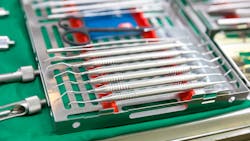Instrument cassettes: What you shouldn’t be doing
Recently, social media and real life have been serving up some interesting behaviors around processing dental instrument cassettes. Let’s talk about it. But first, a friendly reminder: equipment sterilization is an essential part of the daily routine for all dental offices. A patient’s blood or saliva can harbor bacteria and diseases, which may be transmissible to other patients or staff members handling the unsterilized or poorly sterilized instruments. As a result, it is crucial to employ stringent procedures and best practices for cleaning and sterilization to ensure germs from one patient’s mouth do not spread to another’s.
I have recently seen several instances of the improper use of instrument cassettes that could have severe implications for patient and staff safety. For decades, cassettes have been used to manage instruments and have proven effective in reducing compliance risks while increasing safety and sterilization efficacy. The Centers for Disease Control and Prevention (CDC) also recommends their use. Alas, they are only truly effective when handled correctly.1
You're probably transporting your instruments the wrong way
Why Color Method should be in every practice
In one instance, I observed the transfer of instruments from the operatory to the sterilization room, where only then were they placed into cassettes and the ultrasonic for cleaning. The instruments were removed from the cassettes, bagged, and sterilized upon completion of processing. The whole point of cassettes is to limit the handling of soiled instruments. But in this scenario, the staff are handling contaminated equipment far more than necessary.
Removing instruments from cassettes adds an additional step into the workflow, and it increases the risk of sharps injury. We also must keep in mind that the ultrasonic bath is a cesspool containing possibly infectious material from all our patients. We must minimize the risk of injury and cross-contamination following the sterilization process.
Second, I have seen cassettes used that do not fit in the ultrasonic bath. They were placed half in the ultrasonic and then flipped over to clean the other side. The primary issue for me was that the ultrasonic bath was operating without the cover, which is a contraindication and a breach of instructions for use (IFU) that could result in the spread of aerosols. Be sure to verify that your cassettes can be fully immersed in the ultrasonic bath while still adhering to the manufacturer’s operating guidelines.
Baffled by my observations, I discussed them with some of the industry’s top consultants, and the consensus on both scenarios is a firm no. To my surprise, these bad practices are commonly seen and carried out in dental offices all over, and the issue of inadequate equipment processing and sterilization warrants close inspection.
Importance of proper cassette use during instrument reprocessing
Protecting staff members: Cassettes eliminate direct contact with contaminated equipment, keeping instruments together in one place from the treatment room to the cleaning station, sterilization, and storage, until it is time for use on the next patient. Cassettes offer a safe method of transportation as no staff member has to handle the instruments by hand, and the entire cassette can be cleaned immediately in the ultrasonic cleaner.2
However, if you are using cassettes only to load dirty instruments before they go into the ultrasonic bath and then taking them out of the cassettes once the process ends, the use of cassettes becomes counterintuitive, as there is way more handling than necessary. This breach of procedure ultimately means greater risk of injury and cross-transmission.
Prolonging the life of instruments and handpieces: Cassettes are also useful for keeping instruments in their proper positions during cleaning, ensuring that cleaning is effective and that the tools remain protected during the process. Keeping instruments together reduces the likelihood of breakage or loss.
There are cost-saving and time-saving benefits to this, as the life of instruments and equipment can be prolonged due to proper maintenance. There is also no need for staff members to hunt down lost tools or order unnecessary replacements if they are correctly stored. As the treatment provider, you won’t have to worry about not having the right tools where and when you need them.
More efficient organization and workflow: In addition to minimizing unnecessary handling, cassettes can improve organization for a much more efficient workflow.3 They help reduce clutter and bring order to chaos, especially if a color-coded system is used. The entire operation process and team are more streamlined. When new team members join the practice, training and integrating them into the workflow also becomes less of a chore.
Gentle reminder
Instrument cassettes are not considered transportation containers. When moving your dirty dental instruments from the operatory to the sterilization center, the instrument cassette must go into a hard, leak-proof tub with a locking lid and a biohazard sticker. Cassettes are not to be used for transportation. I think any dental professional knows that a scaler could easily poke through an instrument cassette and cause injury while en route to the sterilization center.
Cassettes are a great product to use in the dental office, but improper use must be avoided. If a cassette is too large for the ultrasonic, then the team will need to reassess the size of the ultrasonic bath or determine if there is a way to split the instrument setup into two smaller cassettes that will fit. Minimize how often you handle dirty instruments; it is in your best interests.
Revisiting your office workflow to ensure implementation of best practices and then following them to a T can help prevent any serious problems arising from improper use of instrument cassettes. It is worth it.
Editor's note: This article appeared in the July 2022 print edition of RDH magazine. Dental hygienists in North America are eligible for a complimentary print subscription. Sign up here.
References
1. Sterilization: packaging & storage. Centers for Disease Control and Prevention. Reviewed February 26, 2016. Accessed March 16, 2022. https://www.cdc.gov/oralhealth/infectioncontrol/faqs/packaging-storing.html
2. Molinari JA. Instrument cassettes: a reasonable and effective approach. Dent Econ. January 1, 2009. Accessed March 16, 2022. https://www.dentaleconomics.com/science-tech/article/16389431/instrument-cassettes-a-reasonable-and-effective-approach
3. Molinari J, Harte JA, Nelson P. Instrument cassettes: an effective infection control precaution. Inside Dent. 2013;9(8). Accessed March 16, 2022. https://www.hufriedygroup.com/sites/default/files/IMS-471%20Molinari%20Cassette%20Article%20Inside%20Dentistry%200813.pdf
About the Author
Michelle Strange, RDH
Michelle Strange, RDH, is a dedicated dental hygienist and educator passionate about infection control and patient safety. With over 20 years of experience in clinical practice, Michelle is committed to sharing evidence-based solutions to improve dental care outcomes.

